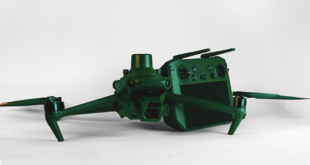Students from Abu Dhabi’s Zayed University (ZU) have designed a synchronised drone system, using multiple drones that can communicate with each other to track down and find missing objects in the desert, including people and cars.
The new invention that aims at maximising drone usage in the fields of investigation and interception was showcased by the students during their participation at the recently concluded Unmanned Systems Exhibition and Conference (Umex ) and Simulation and Training Exhibition and Conference (SimTEX) in Abu Dhabi.
The drone-to-drone communication (DDC) project, developed and designed by Natnael Getahun and Yafiet Araya, undergraduates from the College of Technological Innovation (CTI) at ZU, applied artificial intelligence (AI) technology to enable drones learn and understand missing objects or people, and work together to identify them.
“We can relate to the scenarios of missing cars or people in the desert, our synchronised drones can work together to track the missing objects,” said Araya. “Basically, our project is about how to make two or more drones communicate and integrate with each other and perform a task together, based on the features that you want to apply.”
Getahun said they applied AI onto the system of two drones, which they have successfully coordinated to find an object.
“We entered details of a missing person whom we placed in a certain area. The drones connected via AI communicated and one drone, which found the object, signalled a message to the other unit, making them both return to their base at the same time.”
According to the students, the main purpose of the DDC project is to synchronise multiple drones together and make them communicate for a search objective on a larger scale. As soon as one unit accomplishes the objective, these drones will halt the operation.
Other students from Zayed University’s CTI College, Mariam Almahri and Maryam Alzaabi, developed a system related to drones interception, acquiring forensic image of the drone and controller, and analysing it to extract forensically relevant information or digital evidence for presenting them in the court of law.
“The first task was creating a Wi-Fi attack on test drone in order to intercept it and switch control to a smartphone in our possession. We achieved the task by using ethical hacking techniques via different software tools including Kali Linux,” said Almahri.
“In addition, We managed to extract logical and physical images of the SD card in order to recover data that was stored in the drone, and also managed to acquire the logical image of the drone owner.”
According to Al Zaabi, the purpose of the project is related to safety and security. “We can detect and intercept any strange drones and manage to extract the information on the drone to lead us towards the possessors,” she said.
This article has been adapted from its original source.
 Unmanned Aerial Vehicle The latest drone news
Unmanned Aerial Vehicle The latest drone news


